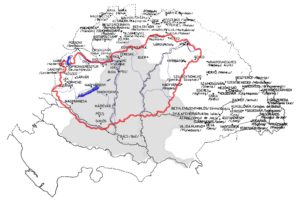Why is the Hungarian Renaissance not so well-known?

Talking about King Matthias Corvinus, we have to realize that the Renaissance existed outside Italy as well. Moreover, it was the court of King Matthias from where the Renaissance spread to Poland and Germany.
Let me quote the comment of Joacim Sprung who remarked upon this in the FB group “The Intriguing Renaissance”:
“Unfortunately, Corvinus and the Hungarian Renaissance are not often mentioned in the standard survey textbooks in art history [Flemming, Stockstad, Janson, etc.]. This is part of an art historiographical bias, and the construction of general art history, that focuses, almost one-dimensionally, on the so-called high streets of Europe. Looking beyond Italian areas, the Low Countries, and the German universe, etc. will let us see other and even more interesting or novel aspects of the Renaissance. Of course, there is a lot written about Corvinus in specialized literature. However, I’m glad that you posted on this topic and encourage everyone living outside ‘the general art history’ areas to do the same. Diversity is good.”
1. The Ottoman wars have almost entirely wiped out our Gothic and Renaissance heritage.
There is not much left, unlike in Italy or in the luckier parts of Europe where the Ottomans could not bring the war: let us not be shy, mainly because the Hungarian-Croatian Borderland protected them. Here you can read about this unique Borderland:
https://www.hungarianottomanwars.com/essays/the-borderland/
Here we can talk about the destruction of Buda, Esztergom, Székesfehérvár, and Visegrád castles and their palaces just to mention the most important royal seats. You can read more about Buda Castle here:
https://www.hungarianottomanwars.com/ottoman-occupied-lands/buda/

The copies of the famous Corvina Library of King Matthias have been destroyed or scattered; statues were broken to pieces, metal objects were melted, schools were closed, and professors and students were chased away or killed. After the taking of Buda in 1541, the middle part of the kingdom became a battlefield for centuries to come. As there was no central Hungarian royal court, the richer Hungarian aristocrats established their courts where Renaissance culture was flourishing, though. We have to take a look at the Nádasdy, the Thurzó, the Eszterházy or the Zrínyi families and many others to discover their cultural activities.
As for the rate of destruction, here you can find more information about it:
https://www.hungarianottomanwars.com/essays/ethnic-changes-in-hungary-due-to-the-ottoman-wars/

2. Most of the surviving Renaissance heritage is not in modern-day Hungary
During the partition of the Hungarian Kingdom after 1541, roughly 70% of the land was lost to the Turks.
If you take a look at the map below that shows you the surviving Renaissance buildings of the Kingdom of Hungary, you will discover that those are located mainly outside the modern Hungarian borders that were drawn in 1918 when again, 72% of the country was lost:

These places that the Ottoman Turks could not reach remained intact and one can adore many examples of the Hungarian Renaissance. However, they are mostly located in Slovakia, Ukraine, and Romania. Unfortunately, during the last 100 years, the usage of the adjective “Hungarian Renaissance” has not been warmly welcomed in these countries. Other labels or no labels at all were being used. However, the 21st century might bring along positive changes when ethnic diversity could be more tolerated.
3. The Transylvanian Renaissance was also flourishing
The Principality of Transylvania was a quite independent Christian state where the Renaissance found its way. For example, take a look at these Renaissance tiles from Transylvania:

You can see more of them here:
https://www.hungarianottomanwars.com/masterpieces-of-art/ceramics-from-the-15-17th-centuries/
Additionally, we have to note how many aspects of the Hungarian Renaissance had been preserved by the Transylvanians until the very day: clothes, attires, dances, music, and architecture, just to mention a few.
You can find many Renaissance palaces and small fortified places of Transylvania on my page, for example here is Bonchida:
https://www.hungarianottomanwars.com/transylvania/bonchida/

4. Plenty of Renaissance forts were built along the Borderland
It is not commonly known that many Renaissance forts were built by Italian engineers in the 16th century, all along the 1,000-mile-long Borderland. The old castles had to be modernized to answer the artillery challenges of the century. The structure of Renaissance forts is unique in itself, many of them are described on my page here:
https://www.hungarianottomanwars.com/castles-in-the-hungaries/

5. Modern social media and the internet
As it is, the Hungarian institutions that are responsible for spreading Hungarian history in the world, do not really care about this task. Yet, there are a few web pages that are very good sources. One of them is a page where you can view the surviving copies of the Corvina Library of King Matthias online:
https://corvina.hu/en/category/virtual-corvinas/all/

Dear Readers, I can only make this content available through small donations or by selling my books or T-shirts:
Please feel free to support me with a coffee here: You can check out my books on Amazon or Draft2Digital, they are available in hardcover, paperback, or ebook:
https://www.amazon.com/dp/198020490Xor at https://books2read.com/b/boYd81

My work can also be followed and supported on Patreon: Become a Patron!



